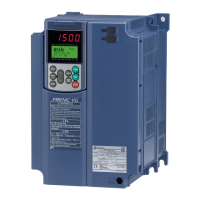5-48
Enable communications link via RS-485 or field bus (option) -- LE
(Function code data = 24)㩷
Turning this terminal command ON assigns priorities to frequency commands or run
commands received via the RS-485 communications link (H30) or the field bus option (y98).
No LE assignment is functionally equivalent to the LE being ON. (Refer to H30
(Communications link function) and y98 (Bus link function.)
Enable auto search for idling motor speed at starting -- STM
(Function code data = 26)㩷
This digital terminal command determines, at the start of operation, whether or not to search
for idling motor speed and follow it. Refer to H09 (Starting mode).
Force to stop -- STOP (Function code data = 30)㩷
Turning this terminal command OFF causes the motor to decelerate to a stop in accordance
with the H56 data (Deceleration time for forced stop). After the motor stops, the inverter enters
the alarm state with the alarm
GT
displayed.
Run forward -- FWD (Function code data = 98)
Turning this terminal command ON runs the motor in the forward direction; turning it OFF
decelerates it to stop.
This terminal command can be assigned only by E98 or E99.
Run reverse -- REV (Function code data = 99)
Turning this terminal command ON runs the motor in the reverse direction; turning it OFF
decelerates it to stop.
This terminal command can be assigned only by E98 or E99.
E20, E21
E27
Terminal [Y1] and [Y2] Function
Terminal [30A/B/C] Function (Relay output)
E20, E21, and E27 assign output signals (listed on the next page) to general-purpose,
programmable output terminals [Y1], [Y2], and [30A/B/C]. These function codes can also
switch the logic system between normal and negative to define the property of those output
terminals so that the inverter logic can interpret either the ON or OFF status of each terminal
as active. The factory default settings are "Active ON."
Terminals [Y1] and [Y2] are transistor outputs and terminals [30A/B/C] are relay contact
outputs. In normal logic, if an alarm occurs, the relay will be energized so that [30A] and [30C]
will be closed, and [30B] and [30C] opened. In negative logic, the relay will be deenergized so
that [30A] and [30C] will be opened, and [30B] and [30C] closed. This may be useful for the
implementation of failsafe power systems.
• When a negative logic is employed, all output signals are active (e.g. an alarm would be
recognized) while the inverter is powered OFF. To avoid causing system malfunctions
by this, interlock these signals to keep them ON using an external power supply.
Furthermore, the validity of these output signals is not guaranteed for approximately 1.5
seconds after power-on, so introduce such a mechanism that masks them during the
transient period.
• Terminals [30A/B/C] use mechanical contacts that cannot stand frequent ON/OFF
switching. Where frequent ON/OFF switching is anticipated (for example, limiting a
current by using signals subjected to inverter output limit control such as switching to
commercial power line), use transistor outputs [Y1] and [Y2] instead. The service life o

